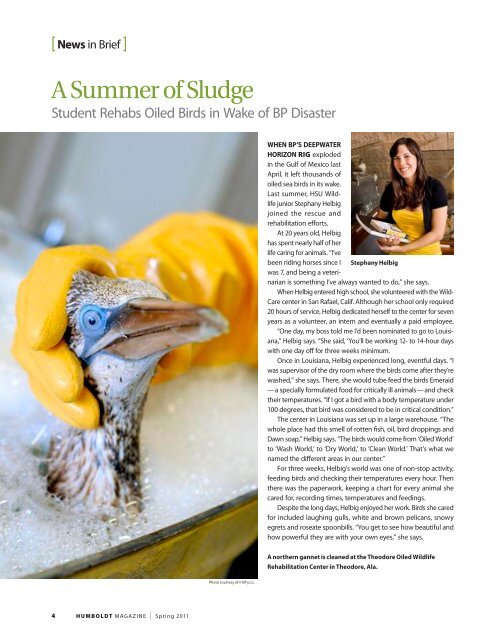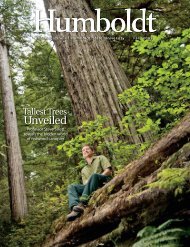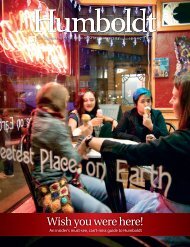ENERGY - Humboldt Magazine - Humboldt State University
ENERGY - Humboldt Magazine - Humboldt State University
ENERGY - Humboldt Magazine - Humboldt State University
You also want an ePaper? Increase the reach of your titles
YUMPU automatically turns print PDFs into web optimized ePapers that Google loves.
[ News in Brief ]<br />
A Summer of Sludge<br />
Student Rehabs Oiled Birds in Wake of BP Disaster<br />
4 HUMBOLDT MAGAZINE | Spring 2011<br />
Photo courtesy of © BP p.l.c.<br />
WhEN BP’S DEEPWATER<br />
hoRIzoN Rig exploded<br />
in the Gulf of Mexico last<br />
April, it left thousands of<br />
oiled sea birds in its wake.<br />
Last summer, HSU Wildlife<br />
junior Stephany Helbig<br />
joined the rescue and<br />
rehabilitation efforts.<br />
At 20 years old, Helbig<br />
has spent nearly half of her<br />
life caring for animals. “I’ve<br />
been riding horses since I Stephany helbig<br />
was 7, and being a veterinarian<br />
is something I’ve always wanted to do,” she says.<br />
When Helbig entered high school, she volunteered with the Wild-<br />
Care center in San Rafael, Calif. Although her school only required<br />
20 hours of service, Helbig dedicated herself to the center for seven<br />
years as a volunteer, an intern and eventually a paid employee.<br />
“One day, my boss told me I’d been nominated to go to Louisiana,”<br />
Helbig says. “She said, ‘You’ll be working 12- to 14-hour days<br />
with one day off for three weeks minimum.<br />
Once in Louisiana, Helbig experienced long, eventful days. “I<br />
was supervisor of the dry room where the birds come after they’re<br />
washed,” she says. There, she would tube feed the birds Emeraid<br />
—a specially formulated food for critically ill animals—and check<br />
their temperatures. “If I got a bird with a body temperature under<br />
100 degrees, that bird was considered to be in critical condition.”<br />
The center in Louisiana was set up in a large warehouse. “The<br />
whole place had this smell of rotten fish, oil, bird droppings and<br />
Dawn soap,” Helbig says. “The birds would come from ‘Oiled World’<br />
to ‘Wash World,’ to ‘Dry World,’ to ‘Clean World.’ That’s what we<br />
named the different areas in our center.”<br />
For three weeks, Helbig’s world was one of non-stop activity,<br />
feeding birds and checking their temperatures every hour. Then<br />
there was the paperwork, keeping a chart for every animal she<br />
cared for, recording times, temperatures and feedings.<br />
Despite the long days, Helbig enjoyed her work. Birds she cared<br />
for included laughing gulls, white and brown pelicans, snowy<br />
egrets and roseate spoonbills. “You get to see how beautiful and<br />
how powerful they are with your own eyes,” she says.<br />
A northern gannet is cleaned at the Theodore oiled Wildlife<br />
Rehabilitation Center in Theodore, Ala.




